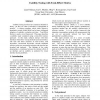Free Online Productivity Tools
i2Speak
i2Symbol
i2OCR
iTex2Img
iWeb2Print
iWeb2Shot
i2Type
iPdf2Split
iPdf2Merge
i2Bopomofo
i2Arabic
i2Style
i2Image
i2PDF
iLatex2Rtf
Sci2ools
ESEM
2009
ACM
2009
ACM
Usability testing with total-effort metrics
Usability testing activities have numerous benefits in theory, yet they are often overlooked or disregarded in practice. A testing paradigm which yields objective, quantitative results would likely lead to more widespread adoption of usability evaluation activities. Total-Effort Metrics is such a novel framework. This paper describes a usability study conducted using a total-effort metrics approach. In this study, subjects interact with three interfaces which have varying element layout proximities. The time and effort measures of time-on-task, total keystrokes, correctional keystrokes, saccade amplitude (point-to-point eye movement) and gaze-path traversal are recorded and analyzed. The findings of the study demonstrate a correlation between the intrinsic effort of an interface and its usability as predicted by extant interface layout guidelines.
ESEM 2009 | Software Engineering | Total-effort Metrics | Usability | Usability Testing Activities |
| Added | 28 May 2010 |
| Updated | 28 May 2010 |
| Type | Conference |
| Year | 2009 |
| Where | ESEM |
| Authors | Liam Feldman, Carl J. Mueller, Dan E. Tamir, Oleg V. Komogortsev |
Comments (0)

